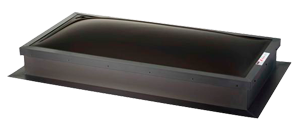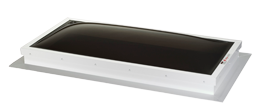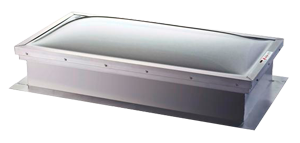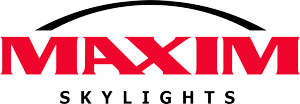All Maxim Skylights are manufactured with extruded aluminum shapes custom designed by our engineers for our unique application. The strength, rigidity and stability of aluminum is derived from the alloy of the billet from which the aluminum shapes come and the temper which is the heat tempering process at the end of the extrusion process. Maxim uses an alloy of 6063 and a temper grade of T5 – T6 which is high on the temper scale. Maxim is required by our Certified Quality Assurance Program with The National Accreditation & Management Institute (NAMI), Miami-Dade County Florida, The State of Florida, and The State of Texas to maintain strict records from the aluminum mill to confirm that the alloy and tempered are within set tolerances. No deviation is acceptable! This allows Maxim to consistently provide only the highest quality skylights to our customers.
Dark Bronze or Clear Anodized
 Anodizing, is an electrolytic process used to increase the thickness of the natural oxide layer on the surface of metal parts. Anodizing increases corrosion resistance and wear resistance, and provides better adhesion for paint primers and glues than bare metal. Anodic films can also be used for a number of cosmetic effects, either with thick porous coatings that can absorb dyes or with thin transparent coatings that add interference effects to reflected light. Anodizing is also used to prevent galling of threaded components and to make dielectric films for electrolytic capacitors. Anodic films are most commonly applied to protect aluminum alloys, although processes also exist for titanium, zinc, magnesium, and niobium. This process is not a useful treatment for iron or carbon steel because these metals exfoliate when oxidized; i.e. the iron oxide (also known as rust) flakes off, constantly exposing the underlying metal to corrosion.
Anodizing, is an electrolytic process used to increase the thickness of the natural oxide layer on the surface of metal parts. Anodizing increases corrosion resistance and wear resistance, and provides better adhesion for paint primers and glues than bare metal. Anodic films can also be used for a number of cosmetic effects, either with thick porous coatings that can absorb dyes or with thin transparent coatings that add interference effects to reflected light. Anodizing is also used to prevent galling of threaded components and to make dielectric films for electrolytic capacitors. Anodic films are most commonly applied to protect aluminum alloys, although processes also exist for titanium, zinc, magnesium, and niobium. This process is not a useful treatment for iron or carbon steel because these metals exfoliate when oxidized; i.e. the iron oxide (also known as rust) flakes off, constantly exposing the underlying metal to corrosion.
Anodizing changes the microscopic texture of the surface and can change the crystal structure of the metal near the surface. Coatings are often porous, even when thick, so a sealing process is often needed to achieve corrosion resistance. The process is called “anodizing” because the part to be treated forms the anode electrode of an electrical circuit. Anodized aluminium surfaces, for example, are harder than aluminium but have low to moderate wear resistance that can be improved with increasing thickness or by applying suitable sealing substances. Anodic films are generally much stronger and more adherent than most types of paint and metal plating, making them less likely to crack and peel.
White Powder Coat or Unlimited Custom Powder Coat Colors
 Powder coating is a type of dry coating, which is applied as a free-flowing, dry powder. The main difference between a conventional liquid paint and a powder coating is that the powder coating does not require a solvent to keep the binder and filler parts in a liquid suspension form. The coating is typically applied electrostatically and is then cured under heat to allow it to flow and form a “skin.” The powder may be a thermoplastic or a thermoset polymer. It is usually used to create a hard finish that is tougher than conventional paint. Powder coating is mainly used for coating of metals, such as aluminum extrusions.
Powder coating is a type of dry coating, which is applied as a free-flowing, dry powder. The main difference between a conventional liquid paint and a powder coating is that the powder coating does not require a solvent to keep the binder and filler parts in a liquid suspension form. The coating is typically applied electrostatically and is then cured under heat to allow it to flow and form a “skin.” The powder may be a thermoplastic or a thermoset polymer. It is usually used to create a hard finish that is tougher than conventional paint. Powder coating is mainly used for coating of metals, such as aluminum extrusions.
Part Preparation Processes & Equipment Removal of oil, soil, lubrication greases, metal oxides, welding scales etc. is essential prior to the powder coating process. It can be done by a variety of chemical and mechanical methods. The selection of the method depends on the size and the material of the part to be powder coated, the type of soil to be removed and the performance requirement of the finished product.
Chemical pre-treatments involve the use of phosphates or chromates in submersion or spray application. These often occur in multiple stages and consist of degreasing, etching, de-smutting, various rinses and the final phosphating or chromating of the substrate. The pre-treatment process both cleans and improves bonding of the powder to the metal. Recent additional processes have been developed that avoid the use of chromates as these can be toxic to the environment such as Titanium Zirconium and Silanes which offers similar performance against corrosion and adhesion of the powder.
When a thermoset powder is exposed to elevated temperature, it begins to melt, flows out, and then chemically reacts to form a higher molecular weight polymer in a network-like structure. This cure process, called crosslinking, requires a certain degree of temperature for a certain length of time in order to reach full cure and establish the full film properties for which the material was designed. Normally the powders cure at 200°C (390°F) in 10 minutes. The curing schedule could vary according to the manufacturer’s specifications.
Mill Finish
 Unfinished as it arrives from the “Mill” hence “Mill Finish”. This finish will oxidize over time presenting a slightly weathered look but in no way is the integrity of the aluminum diminished.
Unfinished as it arrives from the “Mill” hence “Mill Finish”. This finish will oxidize over time presenting a slightly weathered look but in no way is the integrity of the aluminum diminished.
